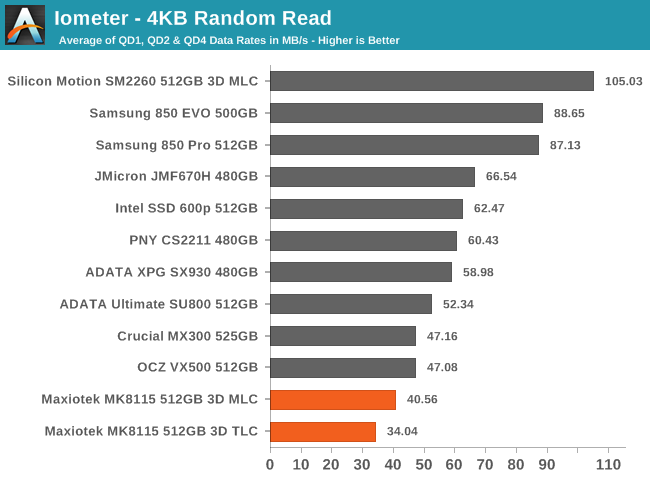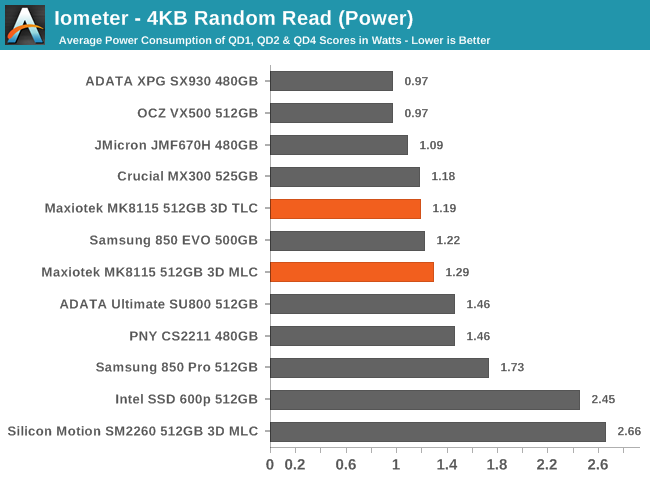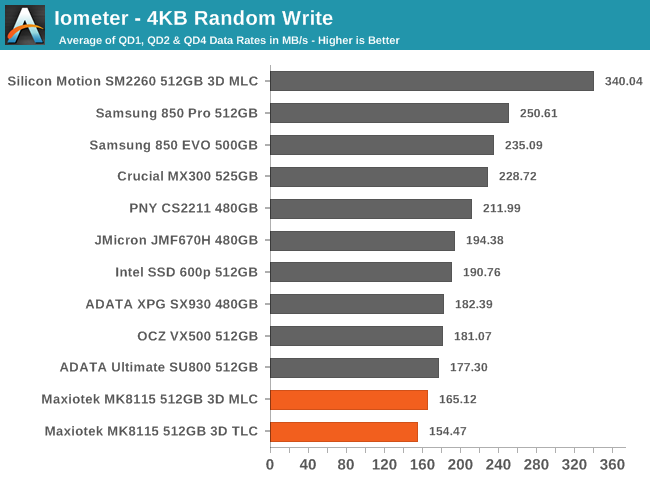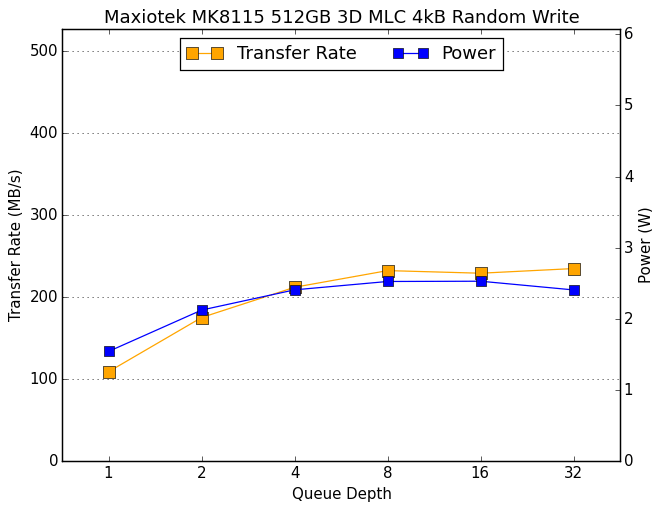Previewing Maxiotek's MK8115 SSD Controller: Can DRAM-less Drives Make The Cut?
by Billy Tallis on May 9, 2017 8:00 AM ESTRandom Read Performance
The random read test requests 4kB blocks and tests queue depths ranging from 1 to 32. The queue depth is doubled every three minutes, for a total test duration of 18 minutes. The test spans the entire drive, which is filled before the test starts. The primary score we report is an average of performances at queue depths 1, 2 and 4, as client usage typically consists mostly of low queue depth operations.

As can be expected, the DRAM-less MK8115 drives come in last in the random read speed test, with the MLC drive 13% slower than the OCZ VX500 and MX300 while the MK8115 TLC drive is closer to 28% slower. Samsung's 850 EVO and PRO are both more than twice as fast as the MK8115 drives.

Power consumption during the random read test is reasonable for both MK8115 drives, but the low performance means neither is particularly efficient.
 |
|||||||||
As queue depths increase both MK8115 samples show moderate increases in performance, tapering off slightly between QD16 and QD32. The MK8115 isn't drawing the most power among SATA SSDs at every single queue depth, but it's close.
Random Write Performance
The random write test writes 4kB blocks and tests queue depths ranging from 1 to 32. The queue depth is doubled every three minutes, for a total test duration of 18 minutes. The test is limited to a 16GB portion of the drive, and the drive is empty save for the 16GB test file. The primary score we report is an average of performances at queue depths 1, 2 and 4, as client usage typically consists mostly of low queue depth operations.

Random write speeds of the MK8115 samples are the slowest out of all the drives in this comparison, but the margin is much smaller than for random reads and nowhere near as large as the disparity in steady-state performance. The difference in performance between the MK8115 samples is smaller than it was for random reads.

The MK8115 drive with MLC levels off after QD8. The TLC counterpart was on track to deliver slightly higher performance at significantly lower power consumption, until the TLC drive filled up and the background garbage collection killed performance and drove up power consumption.
 |
|||||||||
The two MK8115 samples behave rather differently during this random write test. The TLC drive starts out slower at QD1 but performance scales better as queue depth climbs. The TLC drive is also substantially more power efficient, with power consumption growing more slowly than throughput. However, by the end of the test the SLC cache has filled, causing performance to drop below the QD1 throughput and power jumps up to be on par with the MLC drive.










60 Comments
View All Comments
jardows2 - Tuesday, May 9, 2017 - link
I fondly remember when new developments in SSD products resulted in lower prices AND better performance. Now it seems that every new product is geared only for lower prices, and the performance is getting worse! Not to mention that the prices have gone up substantially in the past year, I don't think we are at the best value time for SSD's.MajGenRelativity - Tuesday, May 9, 2017 - link
Can you provide evidence of performance getting worse? I haven't seen groundbreaking performance strides in anything but high-end/upper-mid (Samsung 960 series), but I haven't seen a performance regression.Sonic01 - Tuesday, May 9, 2017 - link
i actually found this today, i was looking for a new budget 1tb SSD.my current is a crucial m500 from 2013 i bagged for about £450, now the cheapest 1tb ss'd are about £300 but overall performance is about 30% of the m500..... in 4 years they have dropped 30% of the cost at the expense of 60% of the speed...
MajGenRelativity - Tuesday, May 9, 2017 - link
I looked on amazon.co.uk and the Samsung 850 Evo is 300 for 1TB. I also paged around in Anandtech reviews, and it has better performance than the M500, sometimes significantly so. The MX300 is 250 for 1TB, and it also scores very well on reviews, although I didn't do a very thorough comparison to the M500, it seems a little lower in performance compared to the 850Evo, which should still put it slightly ahead of the M500AlphaBlaster - Sunday, May 14, 2017 - link
That embecil Comey wanted to grab and be in the headlines, and he was manipulating evidence, etc ,and non-evidence, etc.to accomplish that. That's just one thing. He has no integrity. He showed himself to be just another Washington stooge. Hoover was also another Washington stooge and a degenerate, but was fired by the president that committed the crime that he fired Hoover for. If some entity could lob a couple of nukes onto Washington DC when whatever worthless miscreant president at the time is addressing both houses of congress, it would be a blessing!CheapSushi - Wednesday, May 10, 2017 - link
The big difference is the Crucial M500 is MLC NAND and the Samsung 850 EVO and similar cheaper ones are TLC NAND. TLC is inherently slower than MLC; always. It's 2 bits per cell vs 3 bits per cell. It's an important distinction when comparing SLC, MLC, TLC and soon QLC. Maybe you didn't know?extide - Wednesday, May 10, 2017 - link
Yeah, but the 850 is also using #d TLC, not planar TLC, and 3D TLC is a lot faster than planar TLC. Maybe you didn't know?extide - Wednesday, May 10, 2017 - link
#d is supposed to be 3D, of courselowlymarine - Wednesday, May 10, 2017 - link
If only the very site you were on had some sort of database of benchmarks you could check to see that, in fact, the 850 EVO is massively faster than the M500. Oh hey, look what I found! http://www.anandtech.com/bench/product/805?vs=1398MajGenRelativity - Thursday, May 11, 2017 - link
The 850 Evo is faster though, so I'm not sure what you're trying to say